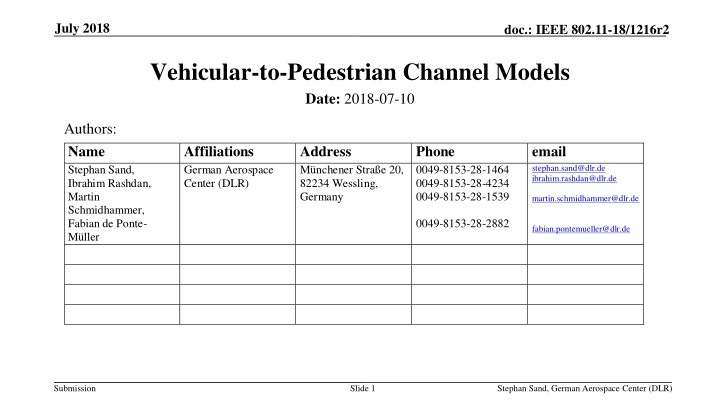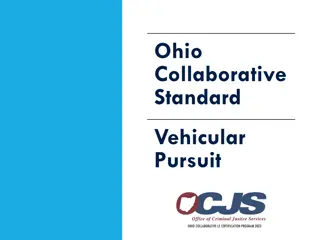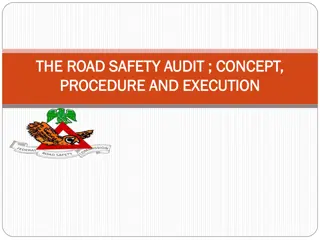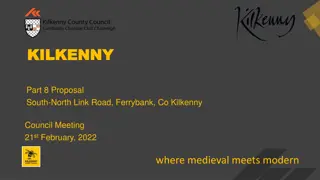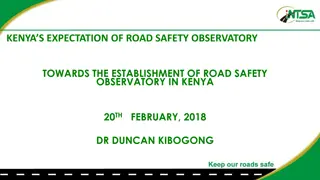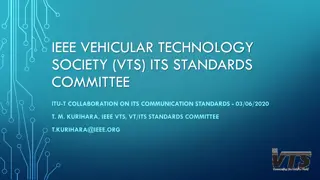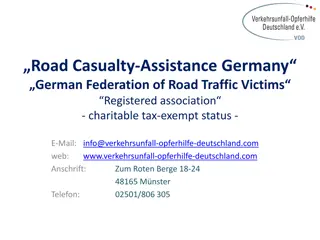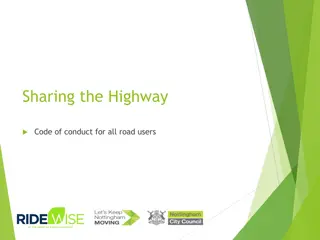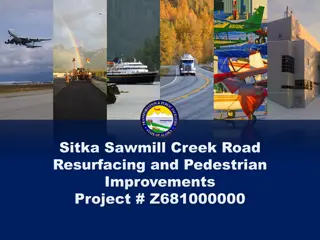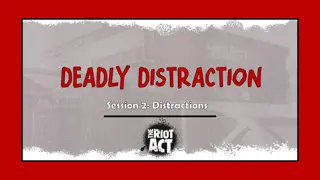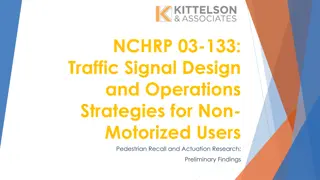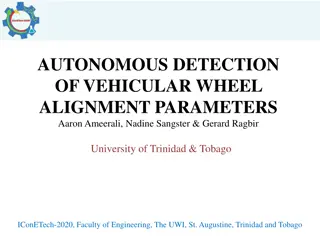Vehicular-to-Pedestrian Channel Models for Improved Road Safety
Protecting vulnerable road users through reliable vehicle-to-pedestrian communications is crucial to reducing accidents. This study emphasizes the need for accurate V2P channel models to enhance communication systems, highlighting the importance of V2P path loss models and comparing V2X channels. Motivated by the high fatality rates among vulnerable road users, the research aims to address limitations in crash avoidance systems and promote direct information exchange between vehicles and pedestrians. Extensive work on V2V and V2I channels exists, but more research is required for V2P channels to ensure reliable communication systems.
Download Presentation

Please find below an Image/Link to download the presentation.
The content on the website is provided AS IS for your information and personal use only. It may not be sold, licensed, or shared on other websites without obtaining consent from the author.If you encounter any issues during the download, it is possible that the publisher has removed the file from their server.
You are allowed to download the files provided on this website for personal or commercial use, subject to the condition that they are used lawfully. All files are the property of their respective owners.
The content on the website is provided AS IS for your information and personal use only. It may not be sold, licensed, or shared on other websites without obtaining consent from the author.
E N D
Presentation Transcript
July 2018 doc.: IEEE 802.11-18/1216r2 Vehicular-to-Pedestrian Channel Models Date: 2018-07-10 Authors: Name Stephan Sand, Ibrahim Rashdan, Martin Schmidhammer, Fabian de Ponte- M ller Affiliations German Aerospace Center (DLR) Address M nchener Stra e 20, 82234 Wessling, Germany Phone 0049-8153-28-1464 0049-8153-28-4234 0049-8153-28-1539 0049-8153-28-2882 email stephan.sand@dlr.de ibrahim.rashdan@dlr.de martin.schmidhammer@dlr.de fabian.pontemueller@dlr.de Submission Slide 1 Stephan Sand, German Aerospace Center (DLR)
July 2018 doc.: IEEE 802.11-18/1216r2 Abstract Protect vulnerable road users with reliable vehicle-to-pedestrian communications to reduce accidents Accurate vehicle-to-pedestrian channel models to design reliable vehicle-to- pedestrian communications Comparison of V2X channels Related work on vehicle-to-pedestrian channel models V2P path loss models Submission Slide 2 Stephan Sand, German Aerospace Center (DLR)
July 2018 doc.: IEEE 802.11-18/1216r2 Motivation Vulnerable road users account for 30% of road fatalities in Europe. Sensor-based crash avoidance systems suffer from limitations. 360 degree awareness by direct exchange of information between vehicles and pedestrians [1] Submission Slide 3 Stephan Sand, German Aerospace Center (DLR)
July 2018 doc.: IEEE 802.11-18/1216r2 Motivation Accurate V2P channel models required for reliable communication system V2I Extensive work has been done for vehicle-to-vehicle (V2V) vehicle-to-infrastructure (V2I) person-to-network (P2N) V2V P2N V2P channel models only 3 recent papers [2] @ 1.85 GHz, [3] @ 3.8 GHz, [4] @ 5.2 GHz Much work to be done! V2P Submission Slide 4 Stephan Sand, German Aerospace Center (DLR)
July 2018 doc.: IEEE 802.11-18/1216r2 Comparison of V2X Channels V2V, V2I and V2P: Different antenna height, mobility pattern, and propagation scenarios different propagation aspects Nonstationary V2V and V2P channels: Time-variant channel statistics due to moving TX, RX, and dynamic environment Signal attenuation: Strong spatio-temporal correlations Stochastic channel models [2]: Large-scale VANET simulators e.g., ns3 and OMNet++ Average packet delivery ratio, but difficult to account for geometry dependent correlations Geometry-based stochastic channel model (GSCM) [3], [4]: Link level and system level simulations in particular for safety-relevant applications such as platooning, automated and remote driving Geometry dependent packet outages, but higher complexity Submission Slide 5 Stephan Sand, German Aerospace Center (DLR)
July 2018 doc.: IEEE 802.11-18/1216r2 Related Work: 3GPP 5G V2X Channel Models & Evaluation Methodology 3GPP 5G V2X use case groups [5]: Vehicle platooning Extended sensors Automated driving Remote driving 5G V2V performance evaluation for use case groups: Adapted parameter sets of GSCM [6] for below and above 6 GHz V2P and V2I models assume same parameters as V2V Realistic? Submission Slide 6 Stephan Sand, German Aerospace Center (DLR)
July 2018 doc.: IEEE 802.11-18/1216r2 Related Work: V2P Channel Models V2P stochastic channel models (SCM) @ 1.85 GHz [2] In-vehicle to pedestrian LOS/NLOS and in pocket/next to face Path loss, shadow, small scale, and multi scale fading parameters based on measurements SCM with combination of Weibull and Rayleigh distributions V2P channel models @ 3.8 GHz [3] Only LOS evaluated RX antenna fixed on long wooden stick untypical, best case pedestrian scenario Two-ray path loss model < 32 meters Submission Slide 7 Stephan Sand, German Aerospace Center (DLR)
July 2018 doc.: IEEE 802.11-18/1216r2 V2P Path Loss Models Based on [4] @ 5.2 GHz: Line-of-Sight (LOS): Static pedestrian: Two-ray ground reflection path loss model Moving pedestrian, texting: Log-distance path loss model + increased shadow fading NLOS due to other nearby pedestrians: 5-10 dB additional path loss due to shadowing NLOS due to parked vehicles: Multiple knife edge diffraction model NLOS due to buildings: Log-distance path loss model (propagation through building) + knife edge diffraction (+ reflections/scattering) Submission Slide 8 Stephan Sand, German Aerospace Center (DLR)
July 2018 doc.: IEEE 802.11-18/1216r2 V2P Path Loss Models: LOS Static Tripod Log-distance path loss model Reference distance d0= 1 m Loss at d0PL(d0) = 46.77 dB Path loss exponent n = 2.03 Log-normal shadow fading Standard deviation ? = 3.23 dB TX RX 2 m 1.1 m 7 m Submission Slide 9 Stephan Sand, German Aerospace Center (DLR)
July 2018 doc.: IEEE 802.11-18/1216r2 V2P Path Loss Models: LOS Moving Pedestrian, Texting Pedestrian antenna at low elevation and close to body Log-distance path loss model Reference distance d0= 1 m Loss at d0PL(d0) = 40 dB Path loss exponent n = 2.44 Log-normal shadow fading Standard deviation ? = 5.47 dB self-body shadowing 1.3 m Submission Slide 10 Stephan Sand, German Aerospace Center (DLR)
July 2018 doc.: IEEE 802.11-18/1216r2 V2P Path Loss Models: NLOS, Crowd Shadowing Nearby other pedestrians Log-distance path loss model Reference distance d0= 1 m Loss at d0PL(d0) = 67 dB Path loss exponent n = 1.26 Log-normal shadow fading Standard deviation ? = 3.35 dB 5-10 dB additional path loss due to shadowing Submission Slide 11 Stephan Sand, German Aerospace Center (DLR)
July 2018 doc.: IEEE 802.11-18/1216r2 V2P Path Loss Models: Parking Cars, NLOS, Diffraction First Results Submission Slide 12 Stephan Sand, German Aerospace Center (DLR)
July 2018 doc.: IEEE 802.11-18/1216r2 V2P Path Loss Models: Parking Cars, NLOS, Diffraction First Results Submission Slide 13 Stephan Sand, German Aerospace Center (DLR)
July 2018 doc.: IEEE 802.11-18/1216r2 V2P Path Loss Models: Parking Cars, NLOS, Diffraction First Results Multiple knife-edge diffraction model + two-ray path loss model Submission Slide 14 Stephan Sand, German Aerospace Center (DLR)
July 2018 doc.: IEEE 802.11-18/1216r2 Conclusions V2P channel different from V2V/V2I channel V2P channel models: Recent papers [2] @ 1.85 GHz, [3] @ 3.8 GHz, [4] @ 5.2 GHz V2P path loss models based on [4]: 3GPP 5G approach realistic? NLOS due to parked vehicles: Multiple knife edge diffraction model LOS static pedestrian: Two-ray pathloss model LOS moving pedestrian, texting: increased shadow fading NLOS due to other nearby pedestrians: 5-10 dB additional path loss due to shadowing Submission Slide 15 Stephan Sand, German Aerospace Center (DLR)
July 2018 doc.: IEEE 802.11-18/1216r2 Conclusions V2P channel different from V2V/V2I channel V2P channel models: Recent papers [2] @ 1.85 GHz, [3] @ 3.8 GHz, [4] @ 5.2 GHz V2P path loss models based on [4]: 3GPP 5G approach realistic? NLOS due to parked vehicles: Multiple knife edge diffraction model LOS static pedestrian: Two-ray pathloss model LOS moving pedestrian, texting: increased shadow fading NLOS due to other nearby pedestrians: 5-10 dB additional path loss due to shadowing Design reliable V2P communications Protect vulnerable road users Accurate V2P channel models Submission Slide 16 Stephan Sand, German Aerospace Center (DLR)
July 2018 doc.: IEEE 802.11-18/1216r2 References [1] Wikipedia https://commons.wikimedia.org/wiki/File:D%C3%A9tection_de_personne_- _exemple_3.jpg [2] Ibdah, Yazan and Ding, Yanwu (2015) Mobile-to-Mobile Channel Measurements at 1.85 GHz in Suburban Environments. IEEE Transactions on Communications, vol. 63, no. 2, Feb. 2015, pp. 466-475 [3] Makhoul, Gloria and D Errico, Raffaele and Oestges, Claude (2018) Wideband Vehicle to Pedestrian Propagation Channel Characterization and Modeling. EuCAP 2018, 9.-13. Apr. 0218, London, UK. [4] Rashdan, Ibrahim and Ponte M ller, Fabian and Wang, Wei und Schmidhammer, Martin und Sand, Stephan (2018) Vehicle-to-Pedestrian Channel Characterization: Wideband Measurement Campaign and First Results. EuCAP 2018, 9.-13. Apr. 2018, London, UK. [5] 3GPP (2018) Study on evaluation methodology of new Vehicle-to-Everything V2X use cases for LTE and NR;(Release 15). TR 37.885, V15.0.0 (2018-06). Submission Slide 17 Stephan Sand, German Aerospace Center (DLR)
July 2018 doc.: IEEE 802.11-18/1216r2 References [6] 3GPP (2018) Study on channel model for frequencies from 0.5 to 100 GHz (Release 15). TR 38.901, V15.0.0 (2018-06). Submission Slide 18 Stephan Sand, German Aerospace Center (DLR)
